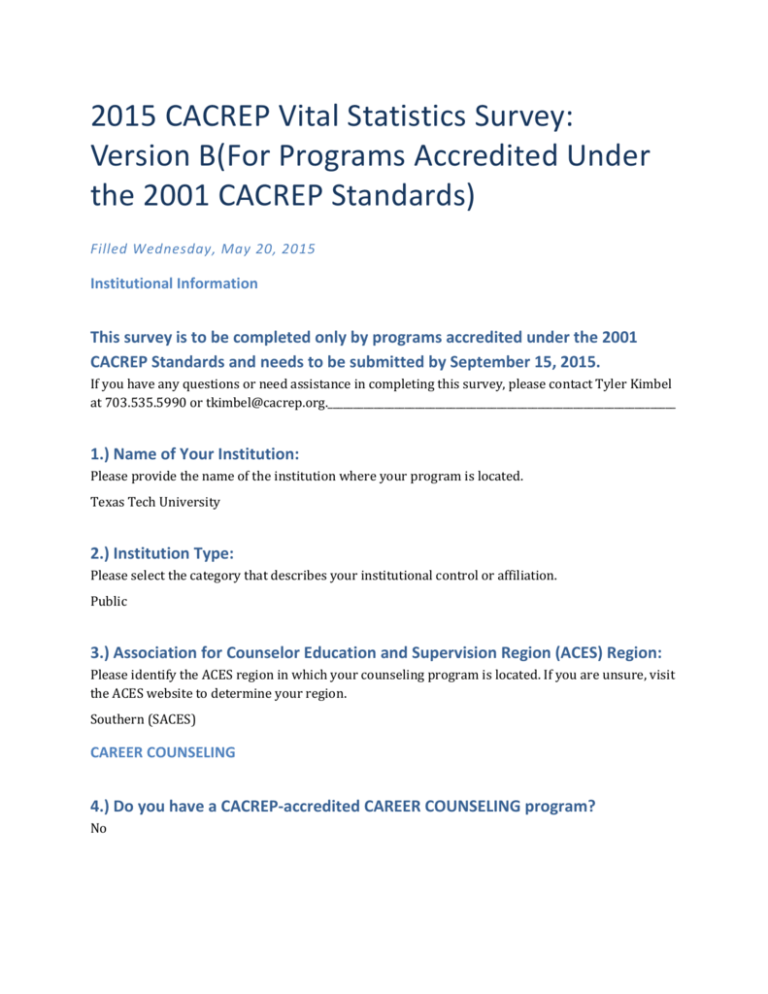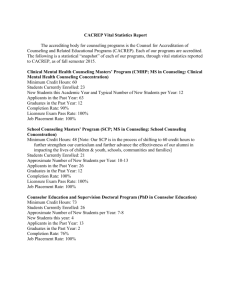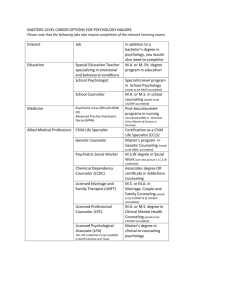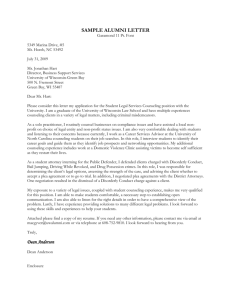2015 CACREP Vital Statistics Survey
advertisement

2015 CACREP Vital Statistics Survey: Version B(For Programs Accredited Under the 2001 CACREP Standards) Filled Wednesday, May 20, 2015 Institutional Information This survey is to be completed only by programs accredited under the 2001 CACREP Standards and needs to be submitted by September 15, 2015. If you have any questions or need assistance in completing this survey, please contact Tyler Kimbel at 703.535.5990 or tkimbel@cacrep.org.____________________________________________________________________ 1.) Name of Your Institution: Please provide the name of the institution where your program is located. Texas Tech University 2.) Institution Type: Please select the category that describes your institutional control or affiliation. Public 3.) Association for Counselor Education and Supervision Region (ACES) Region: Please identify the ACES region in which your counseling program is located. If you are unsure, visit the ACES website to determine your region. Southern (SACES) CAREER COUNSELING 4.) Do you have a CACREP-accredited CAREER COUNSELING program? No COLLEGE COUNSELING 5.) Do you have a CACREP-accredited COLLEGE COUNSELING program? No COMMUNITY COUNSELING 6.) Do you have a CACREP-accredited COMMUNITY COUNSELING program? Yes COMMUNITY COUNSELING Cont'd 6.A.) What is the minimum number of credit (semester) hours required for your COMMUNITY COUNSELING degree? For programs operating on a quarter hour system: Please convert the minimum number of required quarter hours to semester hours by multiplying the number of quarter hours by 2/3 to provide your answer. (Example: If the minimum number of quarter hours required for a degree is 72, then 72 x (2/3) = 48 semester hours.) 48 6.B.) How many students are currently enrolled in your COMMUNITY COUNSELING program? Please provide a headcount of students currently enrolled in your Community Counseling program. ("currently enrolled" = students enrolled in your program at the time this survey is being completed) 88 COMMUNITY COUNSELING PROGRAM/STUDENT OUTCOMES 6.C.) How many students graduated from your COMMUNITY COUNSELING program in the past year? Please provide the combined total number of graduates from Summer 2014, Fall 2014, and Spring 2015. 30 6.D.) To the best of your knowledge, what is the completion rate of students from your COMMUNITY COUNSELING program? To the best of your ability, please use the following information as a guide to report your program's completion rate:A program's completion rate is defined as the percentage of admitted students who graduate from the program within the expected time period. If you admit both full-time and parttime students into the program, you may have two completion rates based on differences between full-time and part-time students' expected time from admission to graduation. If this is the case, your program's completion rate is theaverage of the full-time student completion rate and the parttime student completion rate. 90 6.E.) To the best of your knowledge, what is the licensure [or certification] examination pass rate of students graduating from your COMMUNITY COUNSELING program? Please use the drop down menu below to choose the licensure [or certification] examination pass rate, to the best of your knowledge, of students from your program.(NOTE: CACREP does not dictate the applicable licensure [or certification] examination for any program area in any state. Please provide the licensure [or certification] examination pass rate for the examination that is currently available for students in this program.) 95% 6.F.) To the best of your knowledge, what is the job placement rate of graduates from your COMMUNITY COUNSELING program who were actively seeking employment? To the best of your ability, please use the following calculation as a guide to report your program's job placement rate:Numerator:the number of students who, within 180 days of the day they received their master's counseling degree [in a given award year], obtained employment in the recognized occupation for which they were trained or in a related comparable recognized occupation.Denominator:the number of students who, during the award year, received the master's counseling degree awarded for successfully completing the program and were actively seeking employment. 90 GERONTOLOGICAL COUNSELING 7.) Do you have a CACREP-accredited GERONTOLOGICAL COUNSELING program? No MCFC/T 8.) Do you have a CACREP-accredited MARITAL, COUPLE, AND FAMILY COUNSELING/THERAPY program? No MENTAL HEALTH COUNSELING 9.) Do you have a CACREP-accredited MENTAL HEALTH COUNSELING program? No SCHOOL COUNSELING 10.) Do you have a CACREP-accredited SCHOOL COUNSELING program? Yes SCHOOL COUNSELING Cont'd 10.A.) What is the minimum number of credit (semester) hours required for your SCHOOL COUNSELING degree? For programs operating on a quarter hour system: Please convert the minimum number of required quarter hours to semester hours by multiplying the number of quarter hours by 2/3 to provide your answer. (Example: If the minimum number of quarter hours required for a degree is 72, then 72 x (2/3) = 48 semester hours.) 48 10.B.) How many students are currently enrolled in your SCHOOL COUNSELING program? Please provide a headcount of students currently enrolled in your School Counseling program.("currently enrolled" = students enrolled in your program at the time this survey is being completed) 24 SCHOOL COUNSELING PROGRAM/STUDENT OUTCOMES 10.C.) How many students graduated from your SCHOOL COUNSELING program in the past year? Please provide the combined total number of graduates from Summer 2014, Fall 2014, and Spring 2015. 2 10.D.) To the best of your knowledge, what is the completion rate of students from your SCHOOL COUNSELING program? To the best of your ability, please use the following information as a guide to report your program's completion rate:A program's completion rate is defined as the percentage of admitted students who graduate from the program within the expected time period. If you admit both full-time and parttime students into the program, you may have two completion rates based on differences between full-time and part-time students' expected time from admission to graduation. If this is the case, your program's completion rate is theaverage of the full-time student completion rate and the parttime student completion rate. 95 10.E.) To the best of your knowledge, what is the licensure [or certification] examination pass rate of students graduating from your SCHOOL COUNSELING program? Please use the drop down menu below to choose the licensure [or certification] examination pass rate, to the best of your knowledge, of students from your program.(NOTE: CACREP does not dictate the applicable licensure [or certification] examination for any program area in any state. Please provide the licensure [or certification] examination pass rate for the examination that is currently available for students in this program.) 100% 10.F.) To the best of your knowledge, what is the job placement rate of graduates from your SCHOOL COUNSELING program who were actively seeking employment? To the best of your ability, please use the following calculation as a guide to report your program's job placement rate:Numerator:the number of students who, within 180 days of the day they received their master's counseling degree [in a given award year], obtained employment in the recognized occupation for which they were trained or in a related comparable recognized occupation.Denominator:the number of students who, during the award year, received the master's counseling degree awarded for successfully completing the program and were actively seeking employment. 100 STUDENT AFFAIRS 11.) Do you have a CACREP-accredited STUDENT AFFAIRS program? No Applications and Non CACREP Programs 12.) How many applications for your MASTER'S level CACREP-accredited program(s) did you receive in the past year? Please identify the number of master's program applications you received from June 1, 2014 to May 31, 2015. 63 13.) Non-CACREP-Accredited Programs: Please check all programs offered by your academic counseling unit that are NOT ACCREDITED by CACREP. • None Masters Students w Disabilities 14.) Are you able to provide information about the number of students with disabilities enrolled in your CACREP-accredited MASTER'S level counseling program(s)? You will be asked to provide the number of students with disabilities by gender. Only select "Yes" if you have information about students with disabilities by gender. Yes Masters Students w Disabilities Cont'd 14.A.) How many MALE students with disabilities are enrolled in your CACREPaccredited MASTER'S level counseling programs(s)? 0 14.B.) How many FEMALE students with disabilities are enrolled in your CACREP-accredited MASTER'S level counseling program(s)? 2 14.C.) Alternative Identity: (optional) If there are students with disabilities enrolled in your CACREP-accredited master's level program(s) who identify with a gender category different from above (e.g., transgender), use the text box below to report this information for these students. Please identify one or more alternative/preferred gender categories as well as the headcount of students with disabilities included in each category you list. Note, there is a 500 word limit for responses. (No response) Masters Student Demographics 15.) Are you able to provide racial/ethnic background information about students enrolled in your CACREP-accredited MASTER'S level counseling program(s)? You will be asked to provide the number of students in each racial/ethnic category by gender. Only select "Yes" if you have information about each racial/ethnic category by gender. Yes Masters Student Demographics Cont'd 15.A.) MASTER'S Student Demographics: Please provide the headcount of students currently enrolled in your CACREP-accredited master's level program(s) for each category below. (NOTE: nonresident alien is defined as "A person who is not a citizen or national of the United States and who is in this country on a visa or temporary basis and does not have the right to remain indefinitely.")*All categories require an answer. If you do not have any students that identify with a particular category, please enter "0". Variable Response 15.A.) MASTER'S Student Demographics: | MALE: African American/Black 5 15.A.) MASTER'S Student Demographics: | FEMALE: African American/Black 7 15.A.) MASTER'S Student Demographics: | MALE: American Indian/Native Alaskan 0 15.A.) MASTER'S Student Demographics: | FEMALE: American Indian/Native Alaskan 2 15.A.) MASTER'S Student Demographics: | MALE: Asian American 0 15.A.) MASTER'S Student Demographics: | FEMALE: Asian American 0 15.A.) MASTER'S Student Demographics: | MALE: Caucasian/White 19 15.A.) MASTER'S Student Demographics: | FEMALE: Caucasian/White 58 15.A.) MASTER'S Student Demographics: | MALE: Hispanic/Latino/Spanish American 7 15.A.) MASTER'S Student Demographics: | FEMALE: Hispanic/Latino/Spanish American 12 15.A.) MASTER'S Student Demographics: | MALE: Native Hawaiian/Pacific Islander 0 15.A.) MASTER'S Student Demographics: | FEMALE: Native Hawaiian/Pacific Islander 0 15.A.) MASTER'S Student Demographics: | MALE: Multiracial 0 15.A.) MASTER'S Student Demographics: | FEMALE: Multiracial 0 15.A.) MASTER'S Student Demographics: | MALE: Other/Undisclosed 0 15.A.) MASTER'S Student Demographics: | FEMALE: Other/Undisclosed 1 15.A.) MASTER'S Student Demographics: | MALE: Nonresident Alien 0 15.A.) MASTER'S Student Demographics: | FEMALE: Nonresident Alien 1 15.B.) Alternative Identity: (optional) If there are students enrolled in your CACREP-accredited master's level program(s) who identify with another gender category (e.g., transgender) or race/ethnicity that does not fit with the categories previously provided, use the text box below to report demographic information for these students. Please identify one or more alternative/preferred gender categories as well as the headcount of students included in each category you list and their corresponding race/ethnicity. Note, there is a 500 word limit for responses. (No response) DOCTORAL CES Programs 16.) Do you have a CACREP-accredited doctoral degree program in COUNSELOR EDUCATION AND SUPERVISION? Yes DOCTORAL CES Programs Cont'd 16.A.) What type of COUNSELOR EDUCATION AND SUPERVISION doctoral degree do you offer? Please choose one of the options below. • Ph. D 16.B.) How many credit (semester) hours beyond a CACREP-accredited master's degree do you require for your COUNSELOR EDUCATION AND SUPERVISION doctoral degree? Please provide the specific number of credit (semester) hours required beyond a master's degree.For programs operating on a quarter hour system: Please convert the minimum number of required quarter hours to semester hours by multiplying the number of quarter hours by 2/3 to provide your answer. (Example: If the minimum number of quarter hours required for a doctoral degree is 144, then 144 x (2/3) = 96 semester hours.) 93 16.C.) How many applications for your COUNSELOR EDUCATION AND SUPERVISION doctoral program did you receive in the past year? Please identify the number of doctoral program applications you received from June 1, 2014 to May 31, 2015. 37 16.D.) How many students are currently enrolled in your COUNSELOR EDUCATION AND SUPERVISION doctoral program? Please provide a combined total headcount of doctoral students and doctoral candidates currently enrolled in your doctoral program. ("currently enrolled" = students and candidates enrolled in your program at the time this survey is being completed) 50 COUNSELOR EDUCATION AND SUPERVISION PROGRAM/STUDENT OUTCOMES 16.E.) How many students graduated from your COUNSELOR EDUCATION AND SUPERVISION doctoral program in the past year? Please provide the combined total number of graduates from Summer 2014, Fall 2014, and Spring 2015. 4 16.F.) To the best of your knowledge, what is the completion rate of students from your COUNSELOR EDUCATION AND SUPERVISION doctoral program? To the best of your ability, please use the following information as a guide to report your program's completion rate:A program's completion rate is defined as the percentage of admitted students who graduate from the program within the expected time period. If you admit both full-time and parttime students into the program, you may have two completion rates based on differences between full-time and part-time students' expected time from admission to graduation. If this is the case, your program's completion rate is theaverage of the full-time student completion rate and the parttime student completion rate. 95 16.G.) To the best of your knowledge, what is the job placement rate of graduates from your COUNSELOR EDUCATION AND SUPERVISION doctoral program who were actively seeking employment? To the best of your ability, please use the following calculation as a guide to report your program's job placement rate:Numerator:the number of students who, within 180 days of the day they received their doctoral CES degree [in a given award year], obtained employment in the recognized occupation for which they were trained or in a related comparable recognized occupation.Denominator:the number of students who, during the award year, received the doctoral CES degree awarded for successfully completing the program and were actively seeking employment. 95 Doctoral Students w Disabilities 16.H.) Are you able to provide information about the number of students with disabilities enrolled in your CACREP-accredited COUNSELOR EDUCATION AND SUPERVISION doctoral program? You will be asked to provide the number of students with disabilities by gender. Only select "Yes" if you have information about doctoral students with disabilities by gender. Yes Doctoral Students w Disabilities Cont'd 16.H.i.) How many MALE students with disabilities are enrolled in your CACREPaccredited COUNSELOR EDUCATION AND SUPERVISION doctoral program? 0 16.H.ii.) How many FEMALE students with disabilities are enrolled in your CACREP-accredited COUNSELOR EDUCATION AND SUPERVISION doctoral program? 0 16.H.iii.) Alternative Identity: (optional) If there are students with disabilities enrolled in your CACREP-accredited Counselor Education and Supervision doctoral program who identify with a gender category different from above (e.g., transgender), use the text box below to report this information for these students. Please identify one or more alternative/preferred gender categories as well as the headcount of students with disabilities included in each category you list. Note, there is a 500 word limit for responses. (No response) Doctoral Student Demographics 16.I.) Are you able to provide racial/ethnic background information about students enrolled in your CACREP-accredited COUNSELOR EDUCATION AND SUPERVISION doctoral program? You will be asked to provide the number of students in each racial/ethnic category by gender. Only select "Yes" if you have information about each racial/ethnic category by gender. Yes Doctoral Student Demographics Cont'd 16.I.i.) DOCTORAL Student Demographics: Please provide the headcount for students currently enrolled in your CACREP-accredited Counselor Education and Supervision doctoral program for each category below. (NOTE: nonresident alien is defined as "A person who is not a citizen or national of the United States and who is in this country on a visa or temporary basis and does not have the right to remain indefinitely.")*All categories require an answer. If you do not have any students that identify with a particular category, please enter "0". Variable Response 16.I.i.) DOCTORAL Student Demographics: | MALE: African American/Black 3 16.I.i.) DOCTORAL Student Demographics: | FEMALE: African American/Black 5 16.I.i.) DOCTORAL Student Demographics: | MALE: American Indian/Native Alaskan 0 16.I.i.) DOCTORAL Student Demographics: | FEMALE: American Indian/Native Alaskan 1 16.I.i.) DOCTORAL Student Demographics: | MALE: Asian American 0 16.I.i.) DOCTORAL Student Demographics: | FEMALE: Asian American 0 16.I.i.) DOCTORAL Student Demographics: | MALE: Caucasian/White 12 16.I.i.) DOCTORAL Student Demographics: | FEMALE: Caucasian/White 25 16.I.i.) DOCTORAL Student Demographics: | MALE: Hispanic/Latino/Spanish American 1 16.I.i.) DOCTORAL Student Demographics: | FEMALE: Hispanic/Latino/Spanish American 2 16.I.i.) DOCTORAL Student Demographics: | MALE: Native Hawaiian/Pacific Islander 0 16.I.i.) DOCTORAL Student Demographics: | FEMALE: Native Hawaiian/Pacific Islander 0 16.I.i.) DOCTORAL Student Demographics: | MALE: Multiracial 0 16.I.i.) DOCTORAL Student Demographics: | FEMALE: Multiracial 0 16.I.i.) DOCTORAL Student Demographics: | MALE: Other/Undisclosed 0 16.I.i.) DOCTORAL Student Demographics: | FEMALE: Other/Undisclosed 0 16.I.i.) DOCTORAL Student Demographics: | MALE: Nonresident Alien 0 16.I.i.) DOCTORAL Student Demographics: | FEMALE: Nonresident Alien 1 16.I.ii.) Alternative Identity: (optional) If there are students enrolled in your CACREP-accredited Counselor Education and Supervision doctoral program who identify with another gender category (e.g., transgender) or race/ethnicity that does not fit with the categories previously provided, use the text box below to report demographic information for these students. Please identify one or more alternative/preferred gender categories as well as the headcount of students included in each category you list and their corresponding race/ethnicity. Note, there is a 500 word limit for responses. (No response) Faculty 17.) How many FULL-TIME faculty members do you have in your academic counseling unit? If you have a CES doctoral program, your academic counseling unit is comprised of both your CES doctoral program and your master's level counseling program(s). Please provide only the number of faculty members with full-time appointments in your academic counseling unit. This should be a whole number (i.e., no decimals or fractions). 6 18.) Are you able to provide racial/ethnic background information about FULLTIME faculty members in your academic counseling unit? Similar to the student demographic question, you will be asked to provide the number of full-time faculty in each racial/ethnic category by gender. Only select "Yes" if you have information about each racial/ethnic category by gender. Yes Faculty Demographics 18.A.) FULL-TIME Faculty Demographics: Please provide the headcount of full-time faculty members in your academic counseling unit for each category below. (NOTE: nonresident alien is defined as "A person who is not a citizen or national of the United States and who is in this country on a visa or temporary basis and does not have the right to remain indefinitely.")*All categories require an answer. If you do not have any fulltime faculty that identify with a particular category, please enter "0". Variable Response 18.A.) FULL-TIME Faculty Demographics: | MALE: African American/Black 0 18.A.) FULL-TIME Faculty Demographics: | FEMALE: African American/Black 1 18.A.) FULL-TIME Faculty Demographics: | MALE: American Indian/Native Alaskan 0 18.A.) FULL-TIME Faculty Demographics: | FEMALE: American Indian/Native Alaskan 0 18.A.) FULL-TIME Faculty Demographics: | MALE: Asian American 0 18.A.) FULL-TIME Faculty Demographics: | FEMALE: Asian American 0 18.A.) FULL-TIME Faculty Demographics: | MALE: Caucasian/White 3 18.A.) FULL-TIME Faculty Demographics: | FEMALE: Caucasian/White 2 18.A.) FULL-TIME Faculty Demographics: | MALE: Hispanic/Latino/Spanish American 0 18.A.) FULL-TIME Faculty Demographics: | FEMALE: Hispanic/Latino/Spanish American 0 18.A.) FULL-TIME Faculty Demographics: | MALE: Native Hawaiian/Pacific Islander 0 18.A.) FULL-TIME Faculty Demographics: | FEMALE: Native Hawaiian/Pacific Islander 0 18.A.) FULL-TIME Faculty Demographics: | MALE: Multiracial 0 18.A.) FULL-TIME Faculty Demographics: | FEMALE: Multiracial 0 18.A.) FULL-TIME Faculty Demographics: | MALE: Other/Undisclosed 0 18.A.) FULL-TIME Faculty Demographics: | FEMALE: Other/Undisclosed 0 18.A.) FULL-TIME Faculty Demographics: | MALE: Nonresident Alien 0 18.A.) FULL-TIME Faculty Demographics: | FEMALE: Nonresident Alien 0 18.B.) Alternative Identity: (optional) If there are full-time faculty members in your academic counseling unit who identify with another gender category (e.g., transgender) or race/ethnicity that does not fit with the categories previously provided, use the text box below to report demographic information for these faculty members. Please identify one or more alternative/preferred gender categories as well as the headcount of full-time faculty members included in each category you list and their corresponding race/ethnicity. Note, there is a 500 word limit for responses. (No response) Program Questions 19.) This year CACREP sponsored the second "CACREP Advocacy Week" which took place February 23-27, 2015. Please indicate the Advocacy Week activities in which students and/or faculty members from your program(s) participated (to the best of your knowledge). Use these Advocacy Week activity examples as a reference for your response:*Program Advocacy (ex: submitted a video for the Advocacy Week Video Contest and/or developed an advocacy project to address a need within your own program)*Community Awareness Advocacy (ex: developed brochures, flyers, posters, or presentations to advertise your counseling program and/or raise awareness about who counselors are and the services they provide)*Professional Service Advocacy (ex: sought service opportunities at the local, state, or national level within counseling organizations and/or participated in the IRCEP book drive)*Social Network Advocacy (ex: promoted public awareness of counselors by sharing information via social networks and/or posting about current professional issues in online forums)*Political Advocacy (ex: wrote to state licensure board, department of education, or the ACA Governing Council regarding unified educational standards for counselors and/or licensure portability) • Professional Service Advocacy • Social Network Advocacy • Political Advocacy 20.) CACREP has recently been involved in national discussions related to school counseling and "college and career readiness" (e.g., 2014 White House Convenings). As CACREP continues to work with other national organizations, we would like to better understand how CACREP-accredited School Counseling programs are currently preparing school counselors in this area. 20.A.) To what degree is college and career readiness emphasized within your School Counseling program curriculum? Moderately emphasized 20.B.) What is the title of the graduate course in which college and career readiness information is primarily addressed with your school counseling students? Child & Adolescent Counseling 20.C.) Where are your school counseling students required to demonstrate knowledge and/or skill development related to college and career readiness? • During Coursework • Practicum • Internship 20.D.) If you have any comments related to the "college and career readiness" questions above or about recent state/federal movements in this area, please share them below. (No response) Contact Info/Comments 21.) Please provide a contact email address: This address will be used if the CACREP office has any questions about the information provided in this survey. loretta.bradley@ttu.edu 22.) Final comments? Please share them below: Please note, there is a 500 word limit for comments. More than half our master's students are part-time, so listing the numbers of enrolled students may be misleading. Typically, we have 2-4 adjunct faculty supporting the full-time faculty each semester in the master's programs. Additionally, at this time, approximately half of the doctoral students have completed academic coursework. Of the ones who have completed coursework, more than half have reached the proposal or dissertation stage. As of Fall 2015, our masters in Community Counseling will no longer exist; it will be replaced by a 60-hour Clinical Mental Health Counseling program. REMINDER: Posting Program/Student OutcomesSimilar to previous years, the highlighted heading, “COUNSELING PROGRAM/STUDENT OUTCOMES” was listed undereach individual program area on the 2015 Vital Statistics Survey. Your responses to the questions below this heading need to be made publically available on your program’s website by September 15, 2015, and a hyperlink to that webpage needs to be sent to cacrep@cacrep.org. This link will be made public on the CACREP website to meet recognition requirements set forth by the Council for Higher Education Accreditation (CHEA). The information to be posted includes the following four data points regardingeach of your accredited program areas: (a) number of graduates in the past year, (b) completion rate, (c) licensure or certification examination pass rate, and (d) job placement rate of students/graduates. If you are a new program completing the Vital Statistics Survey for the first time, you need to publically report these data points in a program outcomes report on your program website. Once this report has been posted, you then need to send a hyperlink to the report via email to cacrep@cacrep.org. If your program submitted a Vital Statistics Survey last year and you have previously posted program outcomes on the program website, you need to update your program outcomes report to reflect the most current data. If the hyperlink to the outcomes report changes when you update this information, you need to send a copy of the new hyperlink via email to cacrep@cacrep.org.







